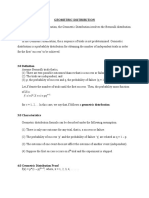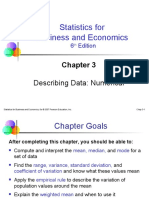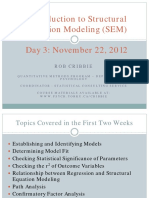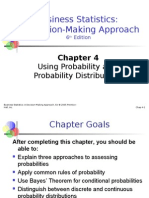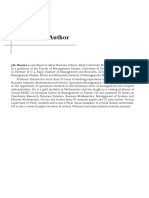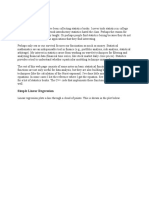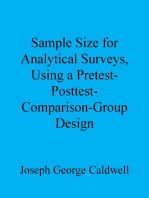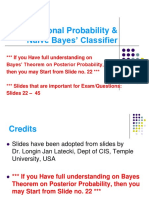Chapter 4 Introduction To Probability
Uploaded by
Muhammad NaeemChapter 4 Introduction To Probability
Uploaded by
Muhammad NaeemChapter 4 Introduction to Probability
Few events are certain to happen.
Probability offers a numeric measure of the
likelihood of an event occurring
IS 310 – Business Statistics Slide 1
Probability as a Numerical Measure
of the Likelihood of Occurrence
Increasing Likelihood of Occurrence
0 .5 1
Probability:
The event The occurrence The event
is very of the event is is almost
unlikely just as likely as certain
to occur. it is unlikely. to occur.
IS 310 – Business Statistics Slide 2
Probability Concepts
To understand probability, one needs to understand
the following concepts:
Experiment
Experimental outcome
Sample space
Sample point
IS 310 – Business Statistics Slide 3
An Experiment and Its Sample Space
An experiment is any process that generates
well-defined outcomes.
The sample space for an experiment is the set of
all experimental outcomes.
An experimental outcome is also called a sample
point.
IS 310 – Business Statistics Slide 4
Experiment and Outcomes
Let’s look at the following experiments and their
outcomes.
Experiment Outcome
Tossing a coin Head, tail
Selecting a part Defective, non-defective
for inspection
Playing ball game Win, lose, tie
Conducting a sales Sale, no sale
call
IS 310 – Business Statistics Slide 5
Counting Outcomes
In order to calculate probability, we must be able to
count the total number of outcomes in an experiment.
In simple experiments, it is easy to know the number
of outcomes. In complex experiments, we need some
rules for counting the number of outcomes.
There are three rules:
Rule for multiple-step experiments
Combination
Permutation
IS 310 – Business Statistics Slide 6
A Counting Rule for
Multiple-Step Experiments
If an experiment consists of a sequence of k steps
in which there are n1 possible results for the first step,
n2 possible results for the second step, and so on,
then the total number of experimental outcomes is
given by (n1)(n2) . . . (nk).
A helpful graphical representation of a multiple-step
experiment is a tree diagram.
IS 310 – Business Statistics Slide 7
Counting Rule for Multi-step Experiments
Let’s take the experiment of tossing two coins. How
many total outcomes are possible in this experiment?
The first coin has two outcomes (H, T)
The second coin has also two outcomes (H, T)
Total outcomes is: (2) (2) = 4
Often, a tree diagram helps. Look at Figure 4.2 (10-
Page 145; 11-Page 152).
IS 310 – Business Statistics Slide 8
Counting Rule for Multi-step Experiments
Let’s take another example.
Kentucky Power & Light Company is starting an
expansion project. The project consists of two stages:
design and construction.
Design work can be completed in 2, 3 or 4 months
(three outcomes)
Construction work can be completed in 6, 7 or 8
months (three outcomes)
Total number of outcomes in this experiment is:
(3) (3) = 9
Look at Table 4.1 and Figure 4.3 (10-Page 146; 11-
Page 153).
IS 310 – Business Statistics Slide 9
Counting Rule for Combinations
A second useful counting rule enables us to count the
number of experimental outcomes when n objects are to
be selected from a set of N objects.
Number of Combinations of N Objects Taken n at a Time
N N!
CnN
n n !(N n )!
where: N! = N(N 1)(N 2) . . . (2)(1)
n! = n(n 1)(n 2) . . . (2)(1)
0! = 1
IS 310 – Business Statistics Slide 10
Counting Rule for Permutations
A third useful counting rule enables us to count the
number of experimental outcomes when n objects are to
be selected from a set of N objects, where the order of
selection is important.
Number of Permutations of N Objects Taken n at a Time
N N!
PnN n !
n (N n )!
where: N! = N(N 1)(N 2) . . . (2)(1)
n! = n(n 1)(n 2) . . . (2)(1)
0! = 1
IS 310 – Business Statistics Slide 11
Example Problems
A home builder offers four different floor plans, three
different exterior designs and two types of roof.
How many ways can a home buyer choose his/her
home?
4 x 3 x 2 = 24
IS 310 – Business Statistics Slide 12
Examples on Combinations and Permutations
Combinations:
How many ways can three Republicans be chosen as members of a
committee from a group of seven Republicans?
7 7!
C = ----------- = 35
3 3! (7 – 3)!
Permutations:
Automobile license plates in a state consists of seven letters of the
alphabets; a letter may not be repeated. How many license plates are
possible?
26 26!
P = --------- = 26 x 25 x 24 x 23 x 22 x 21 x 20
7 (26-7)!
IS 310 – Business Statistics Slide 13
Examples on Combinations and Permutations
Automobile license plates in a state consist of five letters and two
digits. A letter or a digit may be repeated. How many license
plates are possible?
26 26!
The first position may be filled in P = -------------- = 26
1 (26 – 1)!
26 x 26 x 26 x 26 x 26 x 10 x 10
Automobile license plates in CA consist of any combination of
seven letters and/or digits. A letter or a digit may be repeated
seven times. How many license plates are possible?
36 x 36 x 36 x 36 x 36 x 36 x 36
IS 310 – Business Statistics Slide 14
Examples on Combinations and Permutations
Ten individuals are interested in serving on a board of directors. There are
three positions available. How many ways can the selection be made?
10 10!
C = -------------- = 120
3 3! (10 – 3)!
In a class of 40 students, there are 25 women and 15 men. A committee is
to be selected with 5 women and three men. How many ways can this
selection be made?
25 15 25! 15!
C x C = -------------- x -------------
5 3 5! (25 – 5)! 3! (15 – 3)!
IS 310 – Business Statistics Slide 15
Examples on Combinations and Permutations
Five different scholarships are to be awarded to five
students. How many ways can these scholarships be
awarded?
5 5!
P = -------- = 5! = 5 x 4 x 3 x 2 = 120
5 (5 – 5)!
IS 310 – Business Statistics Slide 16
Assigning Probabilities
Classical Method
Assigning probabilities based on the assumption
of equally likely outcomes
Relative Frequency Method
Assigning probabilities based on experimentation
or historical data
Subjective Method
Assigning probabilities based on judgment
IS 310 – Business Statistics Slide 17
Classical Method
If an experiment has n possible outcomes, this method
would assign a probability of 1/n to each outcome.
Example
Experiment: Rolling a die
Sample Space: S = {1, 2, 3, 4, 5, 6}
Probabilities: Each sample point has a
1/6 chance of occurring
IS 310 – Business Statistics Slide 18
Relative Frequency Method
Assigns probabilities based on relative frequencies.
Let’s take the example (10-Page 149; 11-Page 156)
Number of patients waiting for service in the X-ray
department of a hospital:
Number Waiting Number of Days
0 2
1 5
2 6
3 4
4 3
Total 20
IS 310 – Business Statistics Slide 19
Relative Frequency Method
The probability of zero patient waiting for service is:
2/20 = 0.1
The probability of one patient waiting for service is:
5/20 = 0. 25
The probability of two patients waiting for service is:
6/20 = 0.30
And so on.
IS 310 – Business Statistics Slide 20
Subjective Method
When economic conditions and a company’s
circumstances change rapidly it might be
inappropriate to assign probabilities based solely on
historical data.
We can use any data available as well as our
experience and intuition, but ultimately a probability
value should express our degree of belief that the
experimental outcome will occur.
The best probability estimates often are obtained by
combining the estimates from the classical or relative
frequency approach with the subjective estimate.
IS 310 – Business Statistics Slide 21
Sample Problems
Problem # 11 (10-Page 152; 11-Page 159)
a. 858/(858+228) = 858/1,086 = 0.79
b. Yes.
Problem # 12 (10-Page 153; 11-Page 160)
a. 55!/(5!) x (55-5)!
b. 1/[55!/(5!)x(55-50!]
c. 1/[55!/(5!)x(55-5)!] x 1/[42!/(1!)x(42-1)!]
IS 310 – Business Statistics Slide 22
Events and Their Probabilities
An event is a collection of sample points.
The probability of any event is equal to the sum of
the probabilities of the sample points in the event.
If we can identify all the sample points of an
experiment and assign a probability to each, we
can compute the probability of an event.
IS 310 – Business Statistics Slide 23
Events and Their Probabilities
Let’s go back to the example of Kentucky Power &
Light Company.
Suppose, we want to find out the probability of
completing the expansion project in 10 months or
less.
According to Table 4.3, the following sample points
(2,6), (2,7), (2,8), (3,6), (3,7) and (4,6) provide a
completion time of 10 months or less.
Thus, the event C that the project can be completed in
10 months or less is:
P(C) = P(2,6) + P(2,7) + P(2,8) + P(3,6) + P(3,7) + P(4,6)
IS 310 – Business Statistics Slide 24
Sample Problem
Problem #20 (10-Page 157; 11-Page 164)
Given:
State Number of Companies
New York 54
California 52
Texas 48
Illinois 33
Ohio 30
Find: P(N) = Find: P(T) =
Find P(B) =
IS 310 – Business Statistics Slide 25
Some Basic Relationships of Probability
There are some basic probability relationships that
can be used to compute the probability of an event
without knowledge of all the sample point probabilities.
Complement of an Event
Union of Two Events
Intersection of Two Events
Mutually Exclusive Events
IS 310 – Business Statistics Slide 26
Complement of an Event
The complement of event A is defined to be the event
consisting of all sample points that are not in A.
The complement of A is denoted by Ac.
Sample
Event A Ac Space S
Venn
Diagram
IS 310 – Business Statistics Slide 27
Union of Two Events
The union of events A and B is the event containing
all sample points that are in A or B or both.
The union of events A and B is denoted by A B
Sample
Event A Event B Space S
IS 310 – Business Statistics Slide 28
Intersection of Two Events
The intersection of events A and B is the set of all
sample points that are in both A and B.
The intersection of events A and B is denoted by A
Sample
Event A Event B Space S
Intersection of A and B
IS 310 – Business Statistics Slide 29
Addition Law
The addition law provides a way to compute the
probability of event A, or B, or both A and B occurring.
The law is written as:
P(A B) = P(A) + P(B) P(A B
IS 310 – Business Statistics Slide 30
Mutually Exclusive Events
Two events are said to be mutually exclusive if the
events have no sample points in common.
Two events are mutually exclusive if, when one event
occurs, the other cannot occur.
Sample
Event A Event B Space S
IS 310 – Business Statistics Slide 31
Mutually Exclusive Events
If events A and B are mutually exclusive, P(A B = 0.
The addition law for mutually exclusive events is:
P(A B) = P(A) + P(B)
There is no need to
include “ P(A B”
IS 310 – Business Statistics Slide 32
Sample Problem
Problem #24 (10-Page 162; 11-Page 169)
a. Let S = Experience surpassed expectation
N = No response
M= Met expectation
F = Fell short of expectation
P(S) = 1 – P(N) – P(M) – P(F) = 1- 0.04 – 0.65 – 0.26 = 0.05
b. P(M or S) = P(M) + P(S) = 0.65 + 0.05 = 0.70
IS 310 – Business Statistics Slide 33
Sample Problem
Problem # 28 (10-Page 163; 11-Page 170)
a. P(B or P) = P(B) + P(P) – P(B and P)
= 0.458 + 0.54 – 0.3 = 0.698
b. P(neither B nor P) = 1 – P(B or P)
= 1 – 0.698
= 0.302
IS 310 – Business Statistics Slide 34
Conditional Probability
The probability of an event given that another event
has occurred is called a conditional probability.
The conditional probability of A given B is denoted
by P(A|B).
A conditional probability is computed as follows :
P( A B )
P( A|B)
P( B)
IS 310 – Business Statistics Slide 35
Sample Problem
Problem #33 (10-Page 169-170; 11-Page 176-177)
Reason
Quality Cost/Conv Other Total
FT 0.22 0.20 0.04 0.46
PT 0.21 0.31 0.02 0.54
_________________________________________
0.43 0.51 0.06 1.00
b. School cost/convenience followed by quality
c. P(Q given FT) = 0.22/0.46 = 0.47
d. P(Q given PT) = 0.21/0.54 = 0.39
e. P(A) = 0.46 P(B) = 0.43 P(A and B) = 0.22
Since P(A and B) not equal to P(A) * P(B), the events are
NOT independent
IS 310 – Business Statistics Slide 36
Multiplication Law
The multiplication law provides a way to compute the
probability of the intersection of two events.
The law is written as:
P(A B) = P(B)P(A|B)
IS 310 – Business Statistics Slide 37
Independent Events
If the probability of event A is not changed by the
existence of event B, we would say that events A
and B are independent.
Two events A and B are independent if:
P(A|B) = P(A) or P(B|A) = P(B)
IS 310 – Business Statistics Slide 38
Multiplication Law
for Independent Events
The multiplication law also can be used as a test to see
if two events are independent.
The law is written as:
P(A B) = P(A)P(B)
IS 310 – Business Statistics Slide 39
Miscellaneous Problems
Problem # 50 (10-Page 180; 11-Page 187)
Rating Frequency
Poor 4
Below Average 8
Average 11
Above Average 14
Excellent 13
a. What is the probability that a randomly selected viewer will rate the
new show as average or better?
(11 + 14 + 13) / 50 = 0.76
b. What is the probability that a viewer will rate the show as below
average or worse?
(8 + 4) / 50 = 0.24
IS 310 – Business Statistics Slide 40
Miscellaneous Problems
Problem # 57 (10-Page 183; 11-Page 189)
Given: six percent employees suffered lost-time
accidents last year. Fifteen percent who had lost-time
accidents last year will experience the same this year.
a. What percent employees will experience lost-time
accidents in both years?
(0.06) (0.15) = 0.009
b. (0.06) + (0.15) = 0.21
IS 310 – Business Statistics Slide 41
Miscellaneous Problems
A box contains 20 units of a product of which four are defective and 16 are
good. Four units are selected at random. Calculate the following
probabilities:
a. All four units are defective
P(4D) = P(D) . P(D). P(D). P(D) = (4/20) (3/19) (2/18) (1/17) = 1/4845
b. Two units are defective and two units are good
Two defective units must come Two good units must come from
from the four defective units: the sixteen good units:
4 16
C = 6 ways C = 120 ways
2 2
IS 310 – Business Statistics Slide 42
Miscellaneous Problems Continued
Four units can be selected from the original 20 units in
20
C = 4845 ways
4
(6) (120)
P(2D and 2G) = ----------- = 144/969
4845
IS 310 – Business Statistics Slide 43
Miscellaneous Problems Continued
c. At least three units are defective
P(at least 3D) means P(3D or 4D) = P(3D) + P(4D)
4 16 4
C .C C
3 1 4
P(3D) = ----------------- P(4D) = ------------------
20 20
C C
4 4
IS 310 – Business Statistics Slide 44
Miscellaneous Problems
In how many ways can a television director schedule six different
commercials during the six time slots allocated to commercials during
the telecast of the first quarter of a football game?
6
P = 6! = 720
6
Seven wooden dowels of varying lengths are arranged in a row. What is
the probability that the dowels will be arranged in order of size?
2
P(arranged in order of size) = -----------------
7!
IS 310 – Business Statistics Slide 45
End of Chapter 4
IS 310 – Business Statistics Slide 46
You might also like
- USACE BOR Risk For Dams - Guidance Document Piping - Toolbox - Report - Delta 31 July 2008 PDFNo ratings yetUSACE BOR Risk For Dams - Guidance Document Piping - Toolbox - Report - Delta 31 July 2008 PDF337 pages
- An Introduction To Probability: Answers To This Chapter's QuestionsNo ratings yetAn Introduction To Probability: Answers To This Chapter's Questions9 pages
- Statistics For Business and Economics: Describing Data: NumericalNo ratings yetStatistics For Business and Economics: Describing Data: Numerical40 pages
- Sampling Distribution and Simulation in RNo ratings yetSampling Distribution and Simulation in R10 pages
- Introduction To The Normal Distribution PDFNo ratings yetIntroduction To The Normal Distribution PDF6 pages
- Ignou PGDAST Assignment Booklet Jan-Dec 2020No ratings yetIgnou PGDAST Assignment Booklet Jan-Dec 202030 pages
- Statistics - Introduction To Basic ConceptsNo ratings yetStatistics - Introduction To Basic Concepts5 pages
- Business Statistics: A Decision-Making Approach: Using Probability and Probability Distributions100% (2)Business Statistics: A Decision-Making Approach: Using Probability and Probability Distributions41 pages
- Practice MC Questions Solutions-Statistics PDFNo ratings yetPractice MC Questions Solutions-Statistics PDF7 pages
- Introduction To Statistics: Prepared By: Engr. Gilbey'S Jhon - Ladion InstructorNo ratings yetIntroduction To Statistics: Prepared By: Engr. Gilbey'S Jhon - Ladion Instructor25 pages
- Formula Sheet (1) Descriptive Statistics: Quartiles (n+1) /4 (n+1) /2 (The Median) 3 (n+1) /4No ratings yetFormula Sheet (1) Descriptive Statistics: Quartiles (n+1) /4 (n+1) /2 (The Median) 3 (n+1) /413 pages
- Statistics For Business and Economics: Hypothesis Testing IINo ratings yetStatistics For Business and Economics: Hypothesis Testing II48 pages
- Statistics For Business and Economics: Discrete Random Variables and Probability DistributionsNo ratings yetStatistics For Business and Economics: Discrete Random Variables and Probability Distributions59 pages
- Basic Statistics: Simple Linear RegressionNo ratings yetBasic Statistics: Simple Linear Regression8 pages
- Chapter 9. Test of Hypotheses For A Single SampleNo ratings yetChapter 9. Test of Hypotheses For A Single Sample98 pages
- The Normal Distribution and Areas Under The Normal CurveNo ratings yetThe Normal Distribution and Areas Under The Normal Curve48 pages
- 20180808085223D4998 - Chapter - 07 Continuous Probability DistributionsNo ratings yet20180808085223D4998 - Chapter - 07 Continuous Probability Distributions31 pages
- Basic Business Statistics: Analysis of VarianceNo ratings yetBasic Business Statistics: Analysis of Variance85 pages
- 02-03 ASAP Business Analytics-2 Descriptive StatisticsNo ratings yet02-03 ASAP Business Analytics-2 Descriptive Statistics109 pages
- Examples of Continuous Probability Distributions:: The Normal and Standard NormalNo ratings yetExamples of Continuous Probability Distributions:: The Normal and Standard Normal57 pages
- Sample Size for Analytical Surveys, Using a Pretest-Posttest-Comparison-Group DesignFrom EverandSample Size for Analytical Surveys, Using a Pretest-Posttest-Comparison-Group DesignNo ratings yet
- Notes On Econometrics I: Grace MccormackNo ratings yetNotes On Econometrics I: Grace Mccormack50 pages
- Ingreso Reez Juzriel - A Phylogenetic and Biogeographic Study of Rafflesia (Rafflesiaceae) in The - 100215No ratings yetIngreso Reez Juzriel - A Phylogenetic and Biogeographic Study of Rafflesia (Rafflesiaceae) in The - 10021513 pages
- Chapter 1 - Probability Statistic EconomiNo ratings yetChapter 1 - Probability Statistic Economi46 pages
- [FREE PDF sample] Quantum Measurement Theory and its Applications 1st Edition Kurt Jacobs ebooks100% (1)[FREE PDF sample] Quantum Measurement Theory and its Applications 1st Edition Kurt Jacobs ebooks67 pages
- Which Framework Is Suitable For Online 3D Multi-Object Tracking For Autonomous Driving With Automotive 4D Imaging Radar?No ratings yetWhich Framework Is Suitable For Online 3D Multi-Object Tracking For Autonomous Driving With Automotive 4D Imaging Radar?8 pages
- Families of Distributions On The Circle A Review: Y OtoloNo ratings yetFamilies of Distributions On The Circle A Review: Y Otolo9 pages
- RM - Elements of Generalised Linear Models (GLM) and Inference For GLMNo ratings yetRM - Elements of Generalised Linear Models (GLM) and Inference For GLM11 pages
- Determining The Number of Factors in Exploratory and Confirmatory Factor AnalysisNo ratings yetDetermining The Number of Factors in Exploratory and Confirmatory Factor Analysis16 pages
- Khilyatul Mufida 22010111120040 Lap - Kti Bab 8No ratings yetKhilyatul Mufida 22010111120040 Lap - Kti Bab 827 pages
- A New Look at The Statistical Model Identification-M9tNo ratings yetA New Look at The Statistical Model Identification-M9t8 pages
- Dept of Eco Ets Course Content Mphil EconometricsNo ratings yetDept of Eco Ets Course Content Mphil Econometrics18 pages
- Meta Analysis A Structural Equation Modeling Approach 1st Edition Mike W.-L. Cheung - The full ebook with all chapters is available for download100% (2)Meta Analysis A Structural Equation Modeling Approach 1st Edition Mike W.-L. Cheung - The full ebook with all chapters is available for download57 pages
- Developing Neural Network Applications Using LabviewNo ratings yetDeveloping Neural Network Applications Using Labview105 pages
- Probability Theory: Sargur N. Srihari Srihari@cedar - Buffalo.eduNo ratings yetProbability Theory: Sargur N. Srihari Srihari@cedar - Buffalo.edu49 pages
- 2009-03-24 NAG-DAGA Becker Jessen GrigorasNo ratings yet2009-03-24 NAG-DAGA Becker Jessen Grigoras4 pages
- A Rosenblatt Transformation Method Based On Copula Function For Solving Structural ReliabilityNo ratings yetA Rosenblatt Transformation Method Based On Copula Function For Solving Structural Reliability7 pages
- Classical and Bayesian Estimations On The Generalized Exponential Distribution Using Censored DataNo ratings yetClassical and Bayesian Estimations On The Generalized Exponential Distribution Using Censored Data15 pages
- USACE BOR Risk For Dams - Guidance Document Piping - Toolbox - Report - Delta 31 July 2008 PDFUSACE BOR Risk For Dams - Guidance Document Piping - Toolbox - Report - Delta 31 July 2008 PDF
- An Introduction To Probability: Answers To This Chapter's QuestionsAn Introduction To Probability: Answers To This Chapter's Questions
- Statistics For Business and Economics: Describing Data: NumericalStatistics For Business and Economics: Describing Data: Numerical
- Business Statistics: A Decision-Making Approach: Using Probability and Probability DistributionsBusiness Statistics: A Decision-Making Approach: Using Probability and Probability Distributions
- Introduction To Statistics: Prepared By: Engr. Gilbey'S Jhon - Ladion InstructorIntroduction To Statistics: Prepared By: Engr. Gilbey'S Jhon - Ladion Instructor
- Formula Sheet (1) Descriptive Statistics: Quartiles (n+1) /4 (n+1) /2 (The Median) 3 (n+1) /4Formula Sheet (1) Descriptive Statistics: Quartiles (n+1) /4 (n+1) /2 (The Median) 3 (n+1) /4
- Statistics For Business and Economics: Hypothesis Testing IIStatistics For Business and Economics: Hypothesis Testing II
- Statistics For Business and Economics: Discrete Random Variables and Probability DistributionsStatistics For Business and Economics: Discrete Random Variables and Probability Distributions
- The Normal Distribution and Areas Under The Normal CurveThe Normal Distribution and Areas Under The Normal Curve
- 20180808085223D4998 - Chapter - 07 Continuous Probability Distributions20180808085223D4998 - Chapter - 07 Continuous Probability Distributions
- 02-03 ASAP Business Analytics-2 Descriptive Statistics02-03 ASAP Business Analytics-2 Descriptive Statistics
- Examples of Continuous Probability Distributions:: The Normal and Standard NormalExamples of Continuous Probability Distributions:: The Normal and Standard Normal
- Sample Size for Analytical Surveys, Using a Pretest-Posttest-Comparison-Group DesignFrom EverandSample Size for Analytical Surveys, Using a Pretest-Posttest-Comparison-Group Design
- Ingreso Reez Juzriel - A Phylogenetic and Biogeographic Study of Rafflesia (Rafflesiaceae) in The - 100215Ingreso Reez Juzriel - A Phylogenetic and Biogeographic Study of Rafflesia (Rafflesiaceae) in The - 100215
- [FREE PDF sample] Quantum Measurement Theory and its Applications 1st Edition Kurt Jacobs ebooks[FREE PDF sample] Quantum Measurement Theory and its Applications 1st Edition Kurt Jacobs ebooks
- Which Framework Is Suitable For Online 3D Multi-Object Tracking For Autonomous Driving With Automotive 4D Imaging Radar?Which Framework Is Suitable For Online 3D Multi-Object Tracking For Autonomous Driving With Automotive 4D Imaging Radar?
- Families of Distributions On The Circle A Review: Y OtoloFamilies of Distributions On The Circle A Review: Y Otolo
- RM - Elements of Generalised Linear Models (GLM) and Inference For GLMRM - Elements of Generalised Linear Models (GLM) and Inference For GLM
- Determining The Number of Factors in Exploratory and Confirmatory Factor AnalysisDetermining The Number of Factors in Exploratory and Confirmatory Factor Analysis
- A New Look at The Statistical Model Identification-M9tA New Look at The Statistical Model Identification-M9t
- Meta Analysis A Structural Equation Modeling Approach 1st Edition Mike W.-L. Cheung - The full ebook with all chapters is available for downloadMeta Analysis A Structural Equation Modeling Approach 1st Edition Mike W.-L. Cheung - The full ebook with all chapters is available for download
- Developing Neural Network Applications Using LabviewDeveloping Neural Network Applications Using Labview
- Probability Theory: Sargur N. Srihari Srihari@cedar - Buffalo.eduProbability Theory: Sargur N. Srihari Srihari@cedar - Buffalo.edu
- A Rosenblatt Transformation Method Based On Copula Function For Solving Structural ReliabilityA Rosenblatt Transformation Method Based On Copula Function For Solving Structural Reliability
- Classical and Bayesian Estimations On The Generalized Exponential Distribution Using Censored DataClassical and Bayesian Estimations On The Generalized Exponential Distribution Using Censored Data





